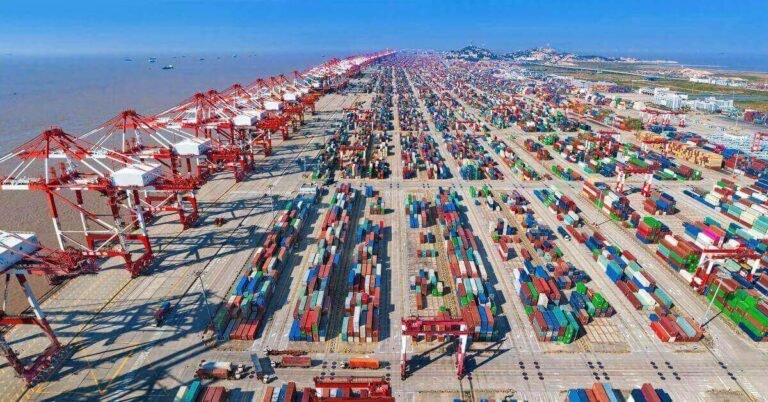The top maritime hubs in the world are not merely seaports but vital nodes in the global transportation network. They are complex ecosystems of logistics, technology and strategic technological advantage, boasting modern infrastructure and automated systems for efficient operations while handling diverse types of cargo.
In this article, we will discuss the Top 5 Maritime Hubs in the World.
1. Port of Shanghai, China
First in our list is none other than China’s Shanghai Port, located at the mouth of the Yangtze River. It is the undisputed leader that has held the position of the world’s busiest container port since 2010.
The sheer volume of cargo it handles is quite impressive, with container throughput exceeding 49 million TEUs annually, per 2023-2024 data. Besides container cargo, the port handles around 1.12 billion tonnes of total cargo every year.
The port provides access to China’s manufacturing and industrial heartland, linking inland production centres with international markets.
Shanghai Port has 3 major working zones, including the Yangshan Deep Water Port, the Huangpu River, and the Yangtze River.
It has 43 container terminals and 191 berths, including the world’s largest automated container terminal located at Yangshan Deep Water Port.
An array of cargo types is handled here, including machines, electronics, manufactured items, textiles, coal, metals, petroleum, steel, oil, chemicals, RORO, etc.
2. Port of Singapore, Singapore
Singapore Port lies at the southern tip of the Malay Peninsula, at the crossroads of the Strait of Malacca and the South China Sea, making it an important link between the Pacific and the Indian Oceans.
Singapore is considered to be the busiest transhipment centre in the world. In 2024, the port handled 622.67 million tonnes of cargo.

It has connections with more than 600 ports in 123 countries, making it a crucial link in the global supply chain.
Its operations are managed by PSA International and Jurong Port, which operates 6 container terminals, namely Tanjong Pagar, Brani, Tuas, Pasir Panjang, Keppel and 3 general-purpose terminals.
Tuas Port is presently under development, is envisioned to become the world’s biggest fully-automated terminal with a capacity of 65 million TEUs once it is completed in the 2040s.
Singapore Port handles a comprehensive range of cargo, including containers, iron ore, coal, grain, cement, steel, breakbulk, project cargo, and oil, petroleum, natural gas, and vehicles. It also has dedicated car terminals.
3. Port of Ningbo-Zhoushan, China
This strategic facility is situated in Zhejiang Province, at the mouth of the Yangtze River.
The mega port has become one of the major maritime hubs in the world, consistently ranking high in both total as well as container throughput.
In 2024, it achieved a record cargo throughput of 1.37 billion metric tonnes and handled 39.3 million TEUs.

The Port Complex consists of 19 port areas and more than 200 large deepwater berths for ships over 10,000 DWT, with over 115 deepwater berths for vessels over 50,000 DWT.
It boasts a high level of automation and has automated container terminals as well as the world’s only automated bulk cargo terminal with dual 400,000-ton capacities on an offshore island.
The port handled an array of cargo, including machinery, electrical appliances, garments, textiles, furniture, toys, iron ore, coal, grain, crude oil, refined oil products, chemicals, steel, timber and vehicles.
4. Port of Shenzhen, China
Positioned in the Pearl River Delta, the Shenzhen Port is a major export hub for South China’s manufacturing sector.
In 2024, the Port achieved a record-breaking cargo throughput of 33.38 million TEUs, which is an 11.7% increase compared to 2024.
This growth can be attributed to several factors like global economic recovery, a robust railway system and the deepening of the Belt and Road Initiative.

The port serves as a vital gateway for exports from the southern Chinese manufacturing areas, especially for clothes, raw materials, electronics and machines.
The Port has 6 main areas, namely Yantian, Nanshan, Dapeng, Dachan Bay, Dachan Island, Bao’an and Xiaochan with a total of 140 berths. This also includes 18 container berths and several others to accommodate ships over 10,000 DWT.
The Port specialises in various exports, including chemicals, medical equipment, tableware, machine parts, plastic moulds, clothing, electronics, along with raw materials for imports. It also handles general cargo and provides ferry services.
5. Port of Rotterdam, Netherlands
Europe’s biggest port is Rotterdam, which is a major gateway to the economic powerhouses of the continent.
In 2024, its container throughput grew to 13.8 million TEUs, with a total cargo throughput of 438 million tonnes.
The port city was once a small fishing village but is now a world-renowned port lying on the Rhine-Meuse delta, facilitating access to the interior of Europe.

It has been expanded continuously over the years to accommodate bigger vessels and newer technologies, cementing its position in international trade and logistics.
Today, the port spans 42 km, with 5 distinct port areas and several terminals.
The port of Rotterdam is one of the largest and busiest ports in the world, handling a wide range of cargo types. This includes 4 main container terminals, including the Maasvlakte 2 terminals like RWG and APM Terminals Maasvlakte II, and ECT Delta Terminal and 20 container depots.
In addition to container handling, the port has specialised terminals for dry bulk, liquid bulk, and RoRo cargo. Its impressive capacity includes a 24 m draught that can accommodate some of the world’s largest ships.
Annually, the port processes over 438 million tonnes of cargo, including containers, petrochemical products, mineral oil products, crude oil, iron ore, coal, grains, chemicals, LNG, and RoRo cargo. Its advanced infrastructure, which includes robotic container operations and automated guided vehicles, ensures the safe and efficient handling of cargo.
In conclusion, the 5 maritime hubs discussed in this article play a crucial role in global maritime trade. Their modern port infrastructure, diverse cargo specialisations, and automated operations enable the efficient flow of cargo across continents.

